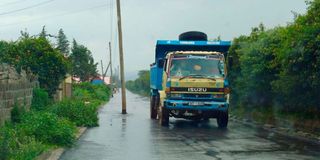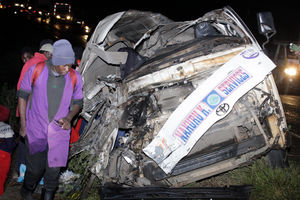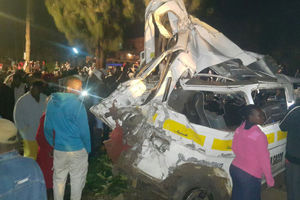
A lorry on the Kiondo-Mashini road in Lanet, Nakuru County on May 7, 2025.
There were celebrations and hope when tarmacking of the Kiondo-Mashini road was completed a few weeks ago.
It was great news for the rural folk as they anticipated increased development in the area that borders Lanet Military Barracks.
However, the three-kilometre stretch of the Lanet-Mashini Road – connecting Kiondo and Mashini – has now become a death trap.
Many accidents have already been reported on the road, which runs parallel to the fence of the garrison. There are several electricity poles in the middle of this road.
“We witness accidents on this road daily. The risk increases at night as the poles are difficult to spot,” Mr John Maina, a frequent use of the road, told the Sunday Nation.
Construction of the road was completed about a month ago but the Kenya Power electricity poles, erected years earlier, were not removed. It was a project of the Kenya Rural Roads Authority (Kerra).

A lorry on the Kiondo-Mashini road in Lanet, Nakuru County on May 7, 2025.
Locals says the poles have become a hazard and now want Kenya Power to move them. A combination of the narrow road and poorly positioned poles has made the stretch perilous for boda bodas, pedestrians and other users. More than 12 people have been injured as a result of the accidents. One death has been reported.
“We use the road cautiously during the day. However, things get more difficult at night, especially when there is a blackout. The poles are invisible in the dark,” Mr Maina added.
Last week, a boda boda died when he hit one of the poles while attempting to avoid hitting a vehicle.
“It happened on May 2. The road has been in use for around a month and we have already lost a life,” Mr Joseph Mureithi, Lanet resident, said.
Ms Martha Waithera, who also resides in the area, recalled what happened.
“It was around 7 pm when word of the accident and death spread. The scene was horrifying. The young man suffered serious head injuries and died on the spot,” she said.
Acting Nakuru County Police Commander, Lilies Wachira – who is also the Nakuru North Sub-County police chief – admitted that the poles are a risk to road users.
“I have used the road in the past and can confirm that it is a nightmare,” the police boss said on Thursday, urging motorists to exercise a lot of caution.
Residents say concerned authorities have not acted despite repeated complaints.
“We have complained to Kerra and Kenya Power but nothing is happening. These agencies must act fast and save lives,” Mr Kimani said.
Calls and texts to South Rift Kenya Power Business Manager, Henry Pwani, went unanswered.
A junior officer told the Sunday Nation that the company is planning to move the poles following many complaints.
“Talks with Kerra and other authorities are on. The poles will soon be shifted,” the officer said, without giving a timeline.
The Kerra office in Nakuru said it did not budget for the removal of the poles and had notified Kenya Power to shift them.
“We wanted a good road and it is good that we finally have one. Unfortunately, the poles are a danger to all. The concerned authorities should not wait for more lives to be lost before acting,” Mr James Mbuthia, a local, said.
Mr Mureithi said the new road already has a nickname.
“We refer to it as ‘Bypass’ because it connects Kiondo and Mashini. It is now the preferred route over the dilapidated Lanet-Mbaruk road,” he said.
Mr Elijah Mburu, a motorist and resident of nearby Ndege Ndimu township, had mixed feelings about the road.
“It is definitely an important link for the wider Lanet region. We genuinely don’t understand what the poles are still doing in the middle of the road. It is frustrating and makes many of us question the planning of the project,” he said.
Mr Mburu added that traffic peaks around 6pm, with the electricity poles only adding to the chaos.
“Drivers have to slow down and carefully avoid the poles. It has become a daily headache,” he said.
There are more than six electricity poles in the middle of the road.
On joining the road from the Nakuru-Nairobi highway, it appears like a one-off oversight. As one continues driving, it becomes clear that there are more poles ahead.
At some point, vehicles have to stop and wait for the others approaching from the opposite direction to pass before proceeding with the journey.







